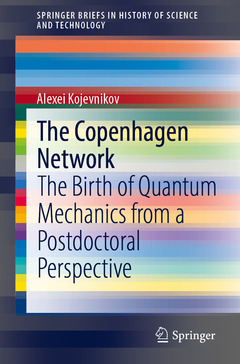The Copenhagen Network, 1st ed. 2020 The Birth of Quantum Mechanics from a Postdoctoral Perspective SpringerBriefs in History of Science and Technology Series
Auteur : Kojevnikov Alexei

1.1 KnabenPhysik
1.2 “Mecca of Theoretical Physics”
Chapter 2 - Scandinavian Settings
2.1 Experiment under Theory
2.2 New Blood
2.3 Meanings of Internationalism
Chapter 3 - International Networking
3.1 The Manchester Link
3.2 First German Connection
3.3 New Partners
3.4 The Value of Neutrality
Chapter 4 - A “Kuhnian” Crisis
4.1 The Field in Disarray
4.2 American Voyage
4.3 The Copenhagen Putsch
Chapter 5 - Revolt of the Postdoc
5.1 Marginal Intruders and the Light Quantum
5.2 Inflation and Quasi-Free Postdocs
5.3 Werner Heisenberg’s Wanderjahre
5.4 Quantum Mechanics Community
Chapter 6 - Philosophical Wrangling
6.1 The Problem with Quantum Philosophy
6.2 Matrix Mechanics (Fall 1925)
6.3 Wave Mechanics (Spring 1926)
6.4 Quantum Mechanics (Fall 1926)
6.5 Philosophies of Compromise (1927)
6.6 Discussion
Chapter 7 - Conclusions and the Forman Thesis
Alexei Kojevnikov received his Ph.D. in History of Science from the Institute for History of Science and Technology in Moscow. After a Humboldt fellowship in Germany and several postdoctoral and faculty positions in the USA, he teaches History of Science at the University of British Columbia, Vancouver, Canada. His research focuses on the history and social relations of modern physics, combining it with approaches from cultural history. He authored Stalin’s Great Science: The Times and Adventures of Soviet Physicists (London, 2004) and Rockefeller Philanthropies and Soviet Science (St. Petersburg, 1993) and edited Science in Russian Context (a special issue of Science in Context, 2002). He is also a Co-Editor of Weimar Culture and Quantum Mechanics (Singapore, 2011), Intelligentsia Science: The Russian Century, 1860-1960 (Chicago, 2008), and Paul Dirac and Physics of the 20th Century (Moscow, 1990).
Describes the first faltering steps of early quantum physicists
Follows the trajectories of young researchers in economically uncertain and difficult times
Is a part of a four-volume collection tracing the development of quantum theory at four European centres
Date de parution : 12-2020
Ouvrage de 126 p.
15.5x23.5 cm



